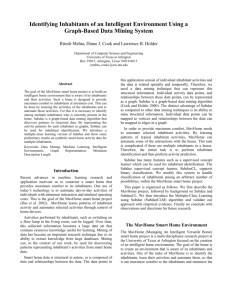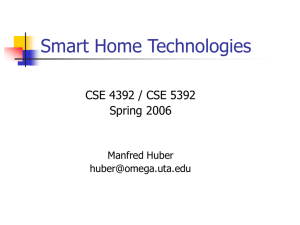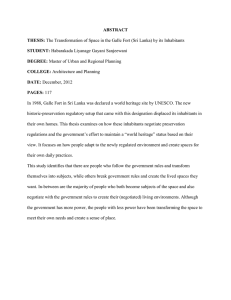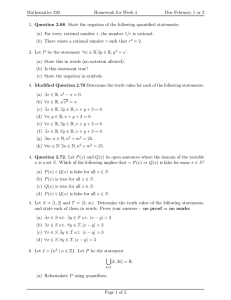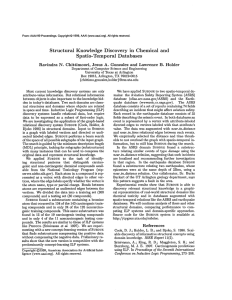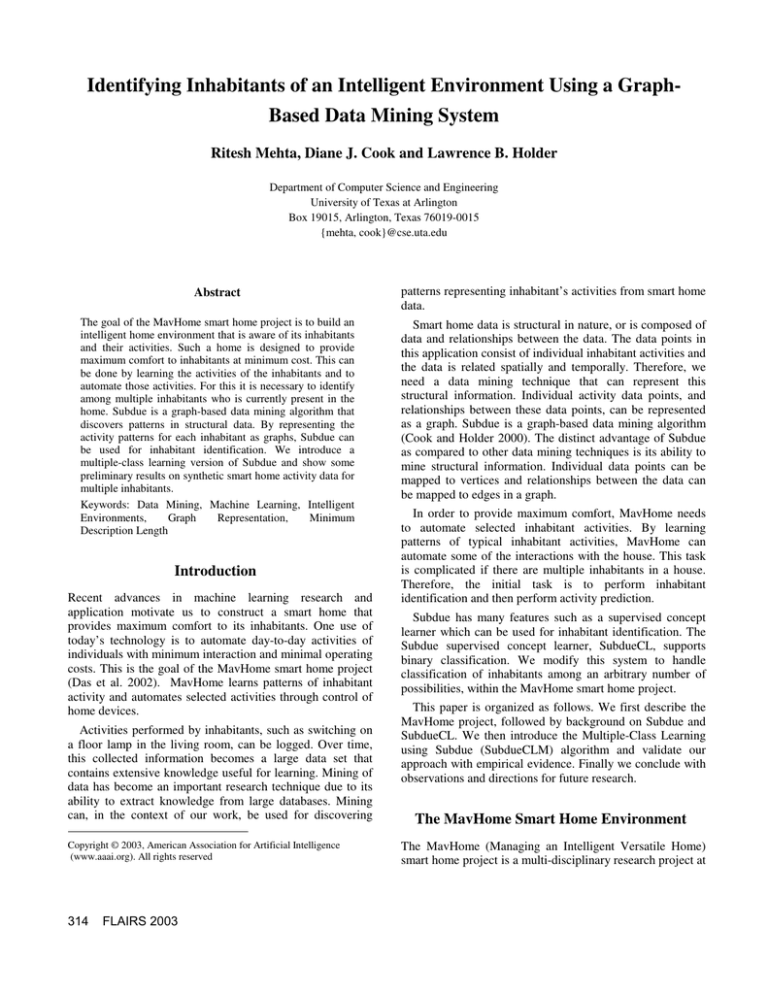
Identifying Inhabitants of an Intelligent Environment Using a GraphBased Data Mining System
Ritesh Mehta, Diane J. Cook and Lawrence B. Holder
Department of Computer Science and Engineering
University of Texas at Arlington
Box 19015, Arlington, Texas 76019-0015
{mehta, cook}@cse.uta.edu
Abstract
patterns representing inhabitant’s activities from smart home
data.
The goal of the MavHome smart home project is to build an
intelligent home environment that is aware of its inhabitants
and their activities. Such a home is designed to provide
maximum comfort to inhabitants at minimum cost. This can
be done by learning the activities of the inhabitants and to
automate those activities. For this it is necessary to identify
among multiple inhabitants who is currently present in the
home. Subdue is a graph-based data mining algorithm that
discovers patterns in structural data. By representing the
activity patterns for each inhabitant as graphs, Subdue can
be used for inhabitant identification. We introduce a
multiple-class learning version of Subdue and show some
preliminary results on synthetic smart home activity data for
multiple inhabitants.
Keywords: Data Mining, Machine Learning, Intelligent
Environments,
Graph
Representation,
Minimum
Description Length
Smart home data is structural in nature, or is composed of
data and relationships between the data. The data points in
this application consist of individual inhabitant activities and
the data is related spatially and temporally. Therefore, we
need a data mining technique that can represent this
structural information. Individual activity data points, and
relationships between these data points, can be represented
as a graph. Subdue is a graph-based data mining algorithm
(Cook and Holder 2000). The distinct advantage of Subdue
as compared to other data mining techniques is its ability to
mine structural information. Individual data points can be
mapped to vertices and relationships between the data can
be mapped to edges in a graph.
Introduction
Recent advances in machine learning research and
application motivate us to construct a smart home that
provides maximum comfort to its inhabitants. One use of
today’s technology is to automate day-to-day activities of
individuals with minimum interaction and minimal operating
costs. This is the goal of the MavHome smart home project
(Das et al. 2002). MavHome learns patterns of inhabitant
activity and automates selected activities through control of
home devices.
Activities performed by inhabitants, such as switching on
a floor lamp in the living room, can be logged. Over time,
this collected information becomes a large data set that
contains extensive knowledge useful for learning. Mining of
data has become an important research technique due to its
ability to extract knowledge from large databases. Mining
can, in the context of our work, be used for discovering
Copyright © 2003, American Association for Artificial Intelligence
(www.aaai.org). All rights reserved
314
FLAIRS 2003
In order to provide maximum comfort, MavHome needs
to automate selected inhabitant activities. By learning
patterns of typical inhabitant activities, MavHome can
automate some of the interactions with the house. This task
is complicated if there are multiple inhabitants in a house.
Therefore, the initial task is to perform inhabitant
identification and then perform activity prediction.
Subdue has many features such as a supervised concept
learner which can be used for inhabitant identification. The
Subdue supervised concept learner, SubdueCL, supports
binary classification. We modify this system to handle
classification of inhabitants among an arbitrary number of
possibilities, within the MavHome smart home project.
This paper is organized as follows. We first describe the
MavHome project, followed by background on Subdue and
SubdueCL. We then introduce the Multiple-Class Learning
using Subdue (SubdueCLM) algorithm and validate our
approach with empirical evidence. Finally we conclude with
observations and directions for future research.
The MavHome Smart Home Environment
The MavHome (Managing an Intelligent Versatile Home)
smart home project is a multi-disciplinary research project at
the University of Texas at Arlington focused on the creation
of an intelligent home environment. The goal of the home is
to create an environment that is aware of its inhabitants and
activities. One of the tasks of MavHome is to identify the
inhabitants, learn their activities and automate them, so that
it can maximize comfort to the inhabitants and minimize the
cost of operations and maintenance. In order to meet these
goals, the home should continuously learn and adapt to the
changing activities of the inhabitants. Our approach is to
view the smart home as an intelligent agent that perceives its
environment through the use of sensors, and can act upon
the environment through the use of actuators. In short, the
home should be able to correctly distinguish between
multiple inhabitants, predict their activities, and select some
of the activities for automation. This information can be
used by the home to pass necessary messages to appropriate
devices in order to automate activities which otherwise
would be performed by the inhabitants manually.
MavHome operations can be characterized by the
following scenario (Das et al. 2002). At 6:45am, MavHome
turns up the heat because it has learned that the home needs
15 minutes to warm to optimal temperature for waking. The
alarm goes off at 7:00, which signals the bedroom light to go
on as well as the coffee maker in the kitchen. One of
MavHome’s inhabitants, Bob, steps into the bathroom and
turns on the light. MavHome records this interaction,
displays the morning news on the bathroom video screen,
and turns on the shower. While Bob is shaving MavHome
senses that Bob is two pounds over his ideal weight and
adjusts Bob'
s suggested menu. When Bob finishes
grooming, the bathroom light turns off while the kitchen
light and menu/schedule display turns on. During breakfast,
Bob notices that the floor is dirty and requests the janitor
robot to clean the house. When Bob leaves for work,
MavHome secures the home, and starts the lawn sprinklers
despite knowing the 70% predicted chance of rain.
This scenario requires a number of tasks to be performed,
including data collection, data mining, and activity
prediction, as well as information passing between multiple
agents. The task of activity prediction is further complicated
if there is more than one inhabitant in a house. Different
inhabitants follow different activity patterns and activities
for some inhabitants may overlap with others. For example,
after Bob steps out of the bathroom, another MavHome
inhabitant, Jack, steps into the bathroom and turns on the
light. This activity of Jack overlaps with Bob, so the home
should be able to distinguish between the Bob and Jack
activities.
As the scenario suggests, MavHome needs to first identify
who is currently in the house and then predict the
inhabitants’ activities. In the case of multiple inhabitants
present at the same time, MavHome needs to distinguish
between the inhabitants’ activities. We hypothesize that this
identification of inhabitants can be performed given a
history of device interactions between inhabitants and
household devices. Due to the structural nature of the data,
Subdue is particularly well suited to the task.
Subdue
Subdue (Cook and Holder 2000) is a graph-based data
mining tool that can discover patterns and learn concepts
from structured data. It is a general tool that can be applied
to any domain that can be represented as a graph. Subdue
expects input to be a labeled graph. Objects in the data are
mapped to vertices and relationships between objects are
mapped to directed or undirected edges.
The main algorithm for discovery is a variant of a beam
search. The goal of the search algorithm is to find a
subgraph that compresses the input graph the best. These
subgraphs, or substructures, are evaluated according to
Minimum Description Length principle, originally
developed by Rissanen (Rissanen 1989). This compression
is calculated as follows:
Compression =
DL ( S ) + DL(G | S )
DL (G )
where DL(G) is the description length of the input graph,
DL(S) is the description length of the subgraph and DL(G|S)
is the description length of the input graph compressed by
the subgraph. The search algorithm tries to maximize the
value of the subgraph, which is simply the inverse of the
compression.
The initial state of the search is the set of subgraphs
consisting of every part of uniquely-labeled vertices, where
each subgraph represents a uniquely-labeled vertex. The
search begins by extending a subgraph in all possible ways
by a single edge and a vertex, or by a single edge if both
vertices are already in the subgraph. The algorithm searches
for the best substructure until all possible substructures have
been considered or the total amount of computation exceeds
a given limit.
Once the search terminates and returns a list of best
subgraphs ordered by compression value, the graph can be
actually compressed using the best subgraph. The
compression procedure replaces all instances of the
subgraph with a pointer to the newly discovered
substructure. The discovered substructures allow abstraction
over detail in the original data. The resulting graph can be
input to another iteration of Subdue, which further
compresses the graph. This process of substructure
discovery and compression can be performed on the graph
until it cannot be further compressed (i.e., the graph is
compressed into a single vertex). After several iterations,
Subdue builds a hierarchical description of the structural
data where substructures discovered later in the process are
defined in terms of substructures discovered during earlier
iterations.
Subdue also has a feature by which predefined
substructures can be provided to Subdue. In this predefined
FLAIRS 2003
315
mode, Subdue will try to find and expand predefined
substructure instances. Subdue reports to the user whether
instances of the predefined substructure occur in the input
graph.
Figure 1 shows a simple example of Subdue’ s operation.
Subdue finds four instances of the triangle-on-square
substructure in the geometric figure. The graph
representation used to describe the substructure, as well as
the input graph, is shown.
Vertices : objects or attributes
Edges : relationships
shape
triangle
object
square
on
object
shape
4 instances of
Figure 1: Subdue Example
The Subdue Concept Learner
Concept learning is a process that consists of the induction
of a function (concept) from training examples. Training
examples are labeled as belonging to class x if they contain
the substructures discovered for concept x. The training
examples are used to guide the search for the target
function. After the learning process, this function must be
capable of correctly classifying a new example, one that
was not included in the training examples. Then, if the
training examples are an accurate representation of their
domain, it is possible to learn a function that will be
accurate when tested with new examples.
Subdue can act as a supervised concept learner (Cook and
Holder 2000). The Subdue concept learner (SubdueCL)
accepts positive and negative examples in graph format.
Substructures that occur often in the positive graph but not
often in the negative graph are likely to be the target
function. Therefore SubdueCL discovers substructures that
compress the positive graph more than the negative graph.
The compression value for a substructure S is calculated as
follows:
Value (G p , G n , S ) = DL (G p , S ) + DL ( S ) + DL (Gn ) − DL (Gn , S )
where DL(G,S) is the description length, according to the
MDL encoding, of a graph G after being compressed using
316
FLAIRS 2003
substructure S and DL(G) is description length of a graph G.
This value represents information needed to represent the
positive graph Gp using the substructure S plus the
information needed to represent the portion of the negative
graph Gn that was compressed using substructure S.
SubdueCL will iterate until it finds a substructure that
compresses the positive graph more than the negative graph.
One of the limitations of this compression-based concept
learner is that it only looks for substructures which compress
the entire positive graph more than the entire negative graph.
Therefore, it is biased to look for a substructure that offers
more compression as compared to a substructure that covers
a greater number of positive examples.
The Subdue set-covering approach (Gonzalez, Holder and
Cook 2001) to concept learning looks for substructures that
cover the greatest possible number of positive examples
while not covering negative examples. The evaluation of
substructure S thus becomes
Value =
# PosEgsCovered + # NegEgsNotCovered
# PosEgs+ # NegEgs
where #PosEgsCovered is the number of positive examples
covered by the substructure and #NegEgsNotCovered is the
number of negative examples not covered by the
substructure. #PosEgs is the total number of positive
examples and #NegEgs is the total number of negative
examples.
Multiple-Class Learning Using Subdue
To date, SubdueCL can perform only binary classification.
However, in the smart home task a classification needs to be
made among multiple possible inhabitants. We have
extended Subdue to learn concepts with multi-valued target
attributes. This algorithm, SubdueCLM, expects an input file
that contains the number of classes that are possible as well
as labeled training data for each class.
SubdueCLM uses SubdueCL to perform classification
separately for each value of the target attribute (in this case,
the inhabitant label). The steps are
1.
Read and create a graph for each class. While
reading, SubdueCLM converts the logged smart
home activity data to a graph.
2.
Iterate for the number of classes specified. During
each iteration, SubdueCLM views the data for one
class value (one inhabitant) as a positive graph and
the collection of the other graphs as a negative
graph. If there are more than two classes, the
graphs representing all classifications except the
current target value are merged into one negative
graph. Substructures are then discovered for these
positive and negative graphs using SubdueCL.
3.
Store the concept found during each iteration for
classification of new data points.
This algorithm will find concepts that represent a target
function for each class. The target function can now be used
to perform classification among previously-unseen
examples. In order to perform classification, the new
inhabitant activity data is converted to a graph. Using the
ability to search for a predefined substructure provided by
Subdue, SubdueCLM can search for the substructures
representing each class value in the new data. If one of the
learned structures is found in the input graph, the
corresponding class value (in this case, inhabitant label) is
reported. Because a smart home may have multiple
inhabitants at home at the same time, all inhabitants whose
patterns are noticed in the data are reported as currently
being present.
Identification of Multiple Inhabitants in
MavHome Using Subdue.
Subdue can be used for identification of inhabitants in
MavHome. A smart home can have many inhabitants.
Therefore, in order to automate activities for each
individual, the home must identify them. SubdueCLM can
be used for identification of a home’ s inhabitants from
observed interactions with the home. In order to use
SubdueCLM we must convert MavHome data to a graph
representation.
An event in a smart home consists of interaction with a
device, such as turning a lamp on or off, playing music, and
starting the water sprinklers. Each event can be considered
as a device whose state is being changed at a particular time.
The event device and event time can be mapped to nodes
with an edge labeled with the state change.
In the smart home graph, consecutive events are
connected with an edge that is labeled with the discretized
time difference between the two events. For example, if the
time difference is less than 5 minutes than the edge is
labeled as ImmediatelyFollows, if the time difference is
more than 5 minutes but less than 15 minutes the edge is
labeled as SoonFollows and so on. The amount of
discretization can be varied according to the application.
A simple example of MavHome data is as follows. The
data follows the format collected by software packages such
as HomeSeer.
(1) 7/7/2001 9:52:07 AM~!~X10 Received~!~A6 (?) A On
(2) 7/7/2001 9:55:07 AM~!~X10 Received~!~A6 (?) A Off
Entries (1) And (2) represents two events. The first entry
indicates that lamp A6 was switched ON at 9:52 am on
7/7/2001 and was switched OFF at 9:55am on the same day.
The corresponding graph representation is shown in Figure
2.
0952
0955
OFF
ON
A6
A6
ImmediatelyFollows
Figure 2: Graph representation of MavHome data
The activity log for each inhabitant collected over a
number of days can be used to train SubdueCLM.
SubdueCLM will find concepts describing each inhabitant’ s
activity pattern. This concept can now be used to classify
new activity logs which were not used to train the system. In
this way, inhabitants can be identified according to the
activity they perform with the house.
Experimental Results
To illustrate the classification of inhabitants using
SubdueCLM, we apply the SubdueCLM algorithm on
synthetic data for three inhabitants, which indicates activities
followed by each inhabitant. The activity patterns for two of
the inhabitants, Ritesh and Sira, overlaps in time. As a
result, a pattern for one individual may be interrupted by
activities for another individual. Activity patterns for the
third inhabitant, Karthik, do not overlap the others.
The primary activity pattern followed by Ritesh is to enter
the environment, play some music, turn ON lights on way to
his desk and at his desk. After some time, Ritesh goes to the
lounge and watches TV. Before leaving, Ritesh turns off the
TV, the lounge light and the light at his desk.
The activity pattern for Sira is similar to that for Ritesh.
Sira enters the environment 15 to 20 minutes after Ritesh
enters, plays some music and turns ON lights at his desk.
Other activities which Sira performs are to close the blinds,
go to the kitchen and select some food to eat from the
refrigerator. Before leaving, Sira switches off the lights at
his desk and in the pathway. Ritesh and Sira are together in
the lab for 20 to 25 minutes.
Karthik’ s activity pattern does not overlap with other two.
After entering the smart environment, Karthik plays some
music, turns on lights on the way to his desk and opens the
blinds. Upon entering the kitchen, Karthik turns on the
kitchen light, opens the refrigerator, and turns off the light
before leaving the kitchen. Before leaving environment,
Karthik watches TV for a while and finally closes the blinds
and switches off the light in the pathway.
The graph representation used for our synthetic data is as
explained in previous section. We use separate labels for
FLAIRS 2003
317
consecutive events occurring within 5 minutes, 15 minutes,
60 minutes, and 120 minutes of each other
Acknowledgements
SubdueCLM is tested using the compression evaluation
heuristic as well as using the set-covering evaluation
heuristic. Experiments used ten days of activity log for each
inhabitant, where seven days worth of data is used for
training and the remaining three days is used for testing.
Subdue version 5.0.3 is used for our experiment.
This work was supported by National Science Foundation
grant IIS-0121297.
The predictive accuracy for SubdueCLM approach is
100% with both evaluation heuristics if log for each
inhabitant is tested individually. We also have tested
SubdueCLM by interleaving activity logs for multiple
inhabitants. The interleaving of data is performed in two
ways. In the first case, an activity log is interleaved
according to the time each event occurs in a day. In this
case, the predictive accuracy is 0% for the Ritesh and Sira
whereas it is 100% for Karthik using the compression
heuristic. For the set-covering approach the predictive
accuracy is 0% for Ritesh, 66.67% for Sira and 100% for
Karthik. In the second case, the activity log is interleaved
according to inhabitant. This means that the log file for three
days of activity for Ritesh is followed by three days of
activity for Sira, and so on. The predictive accuracy in this
case was found to be 100% for each inhabitant for both
approaches.
If the relative order of the events in the activity pattern for
inhabitants is changed then SubdueCLM does not perform
well. Results for MavHome environment show that
SubdueCLM can classify inhabitants correctly if the
inhabitant follows a sequential activity pattern.
Conclusions
In this paper we introduced an algorithm, SubdueCLM, for
classification of multi-valued concepts using the graphbased data mining system Subdue. We demonstrate the
application of SubdueCLM to data from the MavHome
smart home project. The experiments performed using
MavHome data to classify inhabitants based on activity log
show that SubdueCLM can successfully identify inhabitants
from observing inhabitant activity.
There are some enhancements that we would like to make
to SubdueCLM to increase its usefulness for the MavHome
project. We need to refine SubdueCLM to perform
classification when the smart home the activity log contains
partially-ordered events and when activities for multiple
inhabitants overlap. We would like to perform an exhaustive
testing for a different number of inhabitants with different
activity patterns and different amounts of overlapping
between inhabitant activity patterns. We are currently
gathering real activity data that will be used for in-depth
testing of the algorithm. We would also like to apply
SubdueCLM to other domains which can benefit from a
structural approach to multiple-class concept learning.
318
FLAIRS 2003
References
Cook, D. J., and Holder, L. B. 2000. Graph-Based Data
Mining. IEEE Intelligent Systems, 15(2):32-41.
Gonzalez, J., Holder, L. B., and Cook, D. J. 2001. GraphBased Concept Learning. In Proceedings of the Florida
Artificial Intelligence Research Symposium,377-381.
Jonyer, Holder, L. B., and Cook, D. J. 2000. Graph-Based
Hierarchical Conceptual Clustering. In Proceedings of the
Florida AI Research Symposium,91—95.
Das, S. K., Cook, D. J., Bhattacharya, A., Heierman, E. O.
III, and Lin, T.-Y. 2002. The Role of Prediction Algorithms
in the MavHome Smart Home Architecture. IEEE Personal
Communications Special Issue on Smart Homes, Vol 9, No.
6: 77-84.
Gonzalez, J., Jonyer, I., Holder, L. B., and Cook, D. J. 2000.
Efficient Mining of Graph-Based Data. Proceedings of the
AAAI Workshop on Learning Statistical Models from
Relational Data, 21-28.
Jonyer, Cook, D. J., and Holder, L. B. 2001. Discovery and
Evaluation of Graph-Based Hierarchical Conceptual
Clusters. Journal of Machine Learning Research, 2:19-43.
Rissanen, J. 1989. Stochastic Complexity in Statistical
Inquiry. World Scientific Publishing Company.

